|
Related Websites
Waterwear Guide
Clothes for Wild Watersports
waterwearguide.com
Sports Nutrition and Weight Control
vitaminbiz.com
Free Lifesaving Society
Get free lesson plans for survival swimming and lifesaving
freelifesavingsociety.com
Clothes for Swimming
Guide to a wide variety of swimwear
swimwearguide.com
|
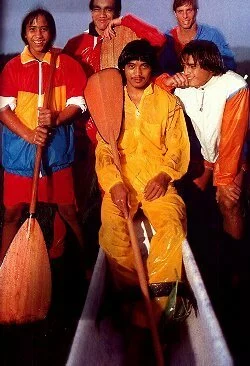
Wear quick drying clothes.
You will get wet.
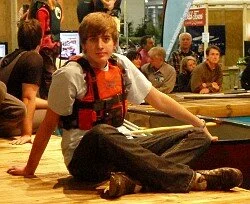
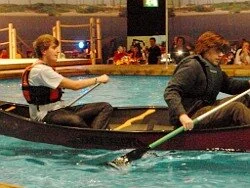
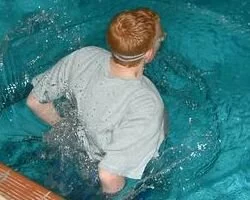
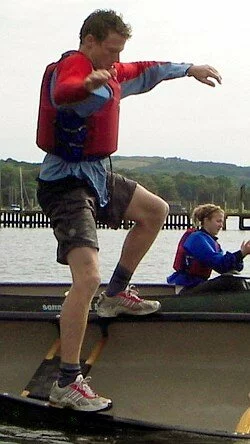
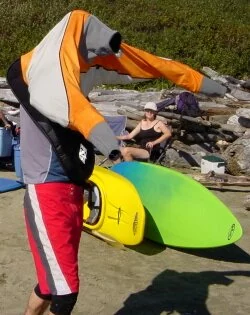
|
Canoeing and Kayaking
|
"Believe me, my young friend, there is nothing, absolutely nothing, half so much worth doing as simply messing about in boats."
Ratty to Mole, The Wind in the Willows
Canoeing and Kayaking are exciting sports if you learn them well. You can paddle to places other water users can't reach, like calm inland waters, whitewater rivers, and along the coast.
Join your friends for a quiet paddle down a lazy river. Enjoy nature in peace and quiet. Go for a swim whenever you like. Paddling your way through the wilderness can be a wonderful opportunity to get some exercise, socialize with friends and explore wild places that are normally inaccessible. That is what canoeing is all about.
If you go out with friends you may want to combine kayaks with canoes and rafts for greater variety. Kayaks can escort the slower canoes or rafts which carry most of your gear. Known for their handling and seaworthiness, kayaks take many shapes depending on their desired use.
Prepare to Get Wet
You should be confident in the water with your head above and below. If you are the kind of person who would panic when under water, think carefully before considering taking up either kayaking or canoeing as a sport or hobby. Anyone considering canoeing lessons should be able to swim at least 50 metres fully clothed.
Boats and Equipment
The instructor may give you an overview on the different types of boats and any must have equipment, like buoyancy aids, life jackets, paddles, spray decks, and the right clothing to help keep you warm. You may also learn about safety measures, capsizes, swimming in clothes, and how to carry your boat. Sometimes they show you a training video. Take good notes so that you can refer back to these at a later date.
Basic Training
After the initial briefing you will be shown the first steps. Some schools train you in a swimming pool first which is great fun. The instructor will demonstrate skills on the water or run through various techniques on land. Then you can jump in and have a go.
| |

|
| |
"I volunteer for the man over board exercise. Shall I jump in now?"
|
Some of the basics include:
- Lifting and carrying of boats
- How to get in and out of the boat
- How to keep your balance
- Man-over-board rescues
- Capsize and swim to shore
- How to empty the boat of water
- How to hold the paddle correctly
- Paddling forwards and backwards
- How to turn the boat
Holding the paddle correctly helps keep the boat in a straight line. If you hold the paddle incorrectly and off-centre the boat goes round and round in circles.
As the training progresses, you will be taught about the potential hazards on the water, rescue techniques and rescue equipment.
As you start to take extra lessons, the skills you will learn get harder, although they can be more important to you, depending on the type of training you choose.
After a few lessons and days out on and in the water you will soon start to get a feel for what you enjoy, then the fun starts. Get ready for days out and even holidays with your team, family and friends.
Canoe Trips and Camping
If you enjoy camping and you'd like to add another dimension to your adventure experience, consider a canoe trip. A canoe trip requires teamwork, a positive attitude, a healthy work ethic and an ability to solve problems and have fun without the many comforts of home, so choose your expedition partners wisely. Although these trips require careful planning, even beginners can arrange a trip suitable to their goals and needs.
The trip you plan should match the ability level of your group. When in doubt, err on the side of caution and choose shorter, fewer portages. Choose areas of water that will be safely navigable for all members of your group.
It is recommended that you have a minimum of three boats on your trip. If something happens to one of the boats, you can still get everyone home in the other two. More boats than that can become cumbersome.
Supplies
There are many items you may want to bring. For anything above and beyond the necessities, consider how much comfort it will give you while camping, versus how much discomfort it will cause you while portaging. Keep in mind that most, if not all, of the necessary equipment can be rented through an outfitting company, so before purchasing any expensive items, it may be wise to try them out first.
|
|